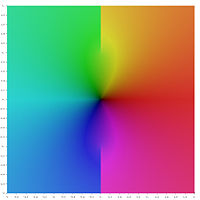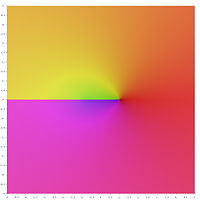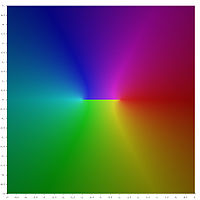Gráficos da função hiperbólica inversa quanto às funções trigonométricas inversas . Na matemática , a função hiperbólica inversa fornece um ângulo hiperbólico correspondente a um determinado valor da função hiperbólica . A magnitude do ângulo hiperbólico é equivalente à área do setor hiperbólico da hipérbole unitária xy = 1x 2 − y 2 = 1círculo unitário .[ 1]
Quanto à nomenclatura, as abreviaturas preferenciais são arsinh, arcosh e assim por diante, sendo estas representantes das funções trigonométricas inversas . Em outros campos, tal como a ciência da computação , a abreviação é feita pelo prefixo asinh e ainda pode ser válido as notações sinh−1 (x ) , cosh−1 (x ) , entre outras.[ 2]
Representação logarítmica Arco seno hiperbólico arsinh x = ln ( x + x 2 + 1 ) {\displaystyle \operatorname {arsinh} x=\ln(x+{\sqrt {x^{2}+1}})} O domínio é o conjunto de números reais .
Demonstração:
x = e y − e − y 2 ⟺ 2 x e y = ( e y ) 2 − 1 {\displaystyle x={\frac {e^{y}-e^{-y}}{2}}\Longleftrightarrow 2xe^{y}=(e^{y})^{2}-1}
Se z = e y , y = ln ( z ) {\displaystyle z=e^{y}\ ,\ y=\ln(z)} 2 x z = z 2 − 1 ⟺ z 2 − 2 x z − 1 = 0 {\displaystyle 2xz=z^{2}-1\Longleftrightarrow z^{2}-2xz-1=0}
z 1 , 2 = 2 x ± 4 x 2 + 4 2 = x ± x 2 + 1 ⟺ y 1 , 2 = ln ( x ± x 2 + 1 ) {\displaystyle z_{1,2}={\frac {2x\pm {\sqrt {4x^{2}+4}}}{2}}\ =x\pm {\sqrt {x^{2}+1}}\Longleftrightarrow y_{1,2}=\ln(x\pm {\sqrt {x^{2}+1}})}
Como x − x 2 + 1 < 0 {\displaystyle x-{\sqrt {x^{2}+1}}<0} ln ( x + x 2 + 1 ) {\displaystyle \ln(x+{\sqrt {x^{2}+1}})}
Arco cosseno hiperbólico arcosh x = ln ( x + x 2 − 1 ) {\displaystyle \operatorname {arcosh} x=\ln(x+{\sqrt {x^{2}-1}})} O domínio é o intervalo fechado [1, +∞ ) .
Demonstração:
x = e y + e − y 2 <==> 2 x e y = ( e y ) 2 + 1 {\displaystyle x={\frac {e^{y}+e^{-y}}{2}}\ <==>\ 2xe^{y}=(e^{y})^{2}+1}
Se z = e y , y = ln ( z ) {\displaystyle z=e^{y}\ ,\ y=\ln(z)} 2 x z = z 2 + 1 <==> z 2 − 2 x z + 1 = 0 <==> {\displaystyle 2xz=z^{2}+1\ <==>\ z^{2}-2xz+1=0\ <==>\ }
z 1 , 2 = 2 x ± 4 x 2 − 4 2 = x ± x 2 − 1 <==> y 1 , 2 = ln ( x ± x 2 − 1 ) {\displaystyle z_{1,2}={\frac {2x\pm {\sqrt {4x^{2}-4}}}{2}}\ =x\pm {\sqrt {x^{2}-1}}\ <==>\ y_{1,2}=\ln(x\pm {\sqrt {x^{2}-1}})}
Como x − x 2 − 1 = 1 x + x 2 − 1 {\displaystyle x-{\sqrt {x^{2}-1}}={\frac {1}{x+{\sqrt {x^{2}-1}}}}} ± ln ( x + x 2 − 1 ) {\displaystyle \pm \ln(x+{\sqrt {x^{2}-1}})} ln ( x + x 2 − 1 ) {\displaystyle \ln(x+{\sqrt {x^{2}-1}})}
Arco tangente hiperbólica artanh x = 1 2 ln ( 1 + x 1 − x ) {\displaystyle \operatorname {artanh} x={\frac {1}{2}}\ln \left({\frac {1+x}{1-x}}\right)} O domínio é o intervalo aberto (−1, 1) .
Arco cotangente hiperbólica arcoth x = 1 2 ln ( x + 1 x − 1 ) {\displaystyle \operatorname {arcoth} x={\frac {1}{2}}\ln \left({\frac {x+1}{x-1}}\right)} O domínio é a união dos intervalos (−∞, −1) e (1, +∞) .
Arco cossecante hiperbólica arcsch x = ln ( 1 x + 1 x 2 + 1 ) = ln ( 1 + 1 + x 2 x ) {\displaystyle \operatorname {arcsch} x=\ln \left({\frac {1}{x}}+{\sqrt {{\frac {1}{x^{2}}}+1}}\right)=\ln \left({\frac {1+{\sqrt {1+x^{2}}}}{x}}\right)} O domínio é o conjunto dos números reais excluindo o 0.
Arco secante hiperbólica arsech x = ln ( 1 x + 1 x 2 − 1 ) = ln ( 1 + 1 − x 2 x ) {\displaystyle \operatorname {arsech} x=\ln \left({\frac {1}{x}}+{\sqrt {{\frac {1}{x^{2}}}-1}}\right)=\ln \left({\frac {1+{\sqrt {1-x^{2}}}}{x}}\right)} O domínio é o intervalo semiaberto (0, 1] .
é real) , algumas simplificações podem ser feitas, como por exemplo, x + 1 x − 1 = x 2 − 1 {\displaystyle {\sqrt {x+1}}{\sqrt {x-1}}={\sqrt {x^{2}-1}}} ln ( 1 + x ) − ln ( 1 − x ) = ln ( 1 + x 1 − x ) {\displaystyle \ln \left({1+x}\right)-\ln \left({1-x}\right)=\ln \left({\tfrac {1+x}{1-x}}\right)}
Fórmulas aditivas arsinh u ± arsinh v = arsinh ( u 1 + v 2 ± v 1 + u 2 ) {\displaystyle \operatorname {arsinh} \;u\pm \operatorname {arsinh} \;v=\operatorname {arsinh} \left(u{\sqrt {1+v^{2}}}\pm v{\sqrt {1+u^{2}}}\right)}
arcosh u ± arcosh v = arcosh ( u v ± ( u 2 − 1 ) ( v 2 − 1 ) ) {\displaystyle \operatorname {arcosh} \;u\pm \operatorname {arcosh} \;v=\operatorname {arcosh} \left(uv\pm {\sqrt {(u^{2}-1)(v^{2}-1)}}\right)}
artanh u ± artanh v = artanh ( u ± v 1 ± u v ) {\displaystyle \operatorname {artanh} \;u\pm \operatorname {artanh} \;v=\operatorname {artanh} \left({\frac {u\pm v}{1\pm uv}}\right)}
arsinh u + arcosh v = arsinh ( u v + ( 1 + u 2 ) ( v 2 − 1 ) ) = arcosh ( v 1 + u 2 + u v 2 − 1 ) {\displaystyle {\begin{aligned}\operatorname {arsinh} \;u+\operatorname {arcosh} \;v&=\operatorname {arsinh} \left(uv+{\sqrt {(1+u^{2})(v^{2}-1)}}\right)\\&=\operatorname {arcosh} \left(v{\sqrt {1+u^{2}}}+u{\sqrt {v^{2}-1}}\right)\end{aligned}}}
Outras identidades 2 arcosh x = arcosh ( 2 x 2 − 1 ) para x ≥ 1 4 arcosh x = arcosh ( 8 x 4 − 8 x 2 + 1 ) para x ≥ 1 2 arsinh x = arcosh ( 2 x 2 + 1 ) para x ≥ 0 4 arsinh x = arcosh ( 8 x 4 + 8 x 2 + 1 ) para x ≥ 0 {\displaystyle {\begin{aligned}2\operatorname {arcosh} x&=\operatorname {arcosh} (2x^{2}-1)&\quad {\hbox{ para }}x\geq 1\\4\operatorname {arcosh} x&=\operatorname {arcosh} (8x^{4}-8x^{2}+1)&\quad {\hbox{ para }}x\geq 1\\2\operatorname {arsinh} x&=\operatorname {arcosh} (2x^{2}+1)&\quad {\hbox{ para }}x\geq 0\\4\operatorname {arsinh} x&=\operatorname {arcosh} (8x^{4}+8x^{2}+1)&\quad {\hbox{ para }}x\geq 0\end{aligned}}}
ln ( x ) = arcosh ( x 2 + 1 2 x ) = arsinh ( x 2 − 1 2 x ) = artanh ( x 2 − 1 x 2 + 1 ) {\displaystyle \ln(x)=\operatorname {arcosh} \left({\frac {x^{2}+1}{2x}}\right)=\operatorname {arsinh} \left({\frac {x^{2}-1}{2x}}\right)=\operatorname {artanh} \left({\frac {x^{2}-1}{x^{2}+1}}\right)}
Derivadas das funções hiperbólicas inversas Derivada de arco seno hiperbólico d d x arsinh x = 1 x 2 + 1 {\displaystyle {\frac {d}{dx}}\,\operatorname {arsinh} \,x={\frac {1}{\sqrt {x^{2}+1}}}}
Derivada de arco cosseno hiperbólico d d x arcosh x = 1 x 2 − 1 {\displaystyle {\frac {d}{dx}}\,\operatorname {arcosh} \,x={\frac {1}{\sqrt {x^{2}-1}}}} 1 < x {\displaystyle 1<x}
Derivada de arco tangente hiperbólico d d x artanh x = 1 1 − x 2 {\displaystyle {\frac {d}{dx}}\,\operatorname {artanh} \,x={\frac {1}{1-x^{2}}}} − 1 < x < 1 {\displaystyle -1<x<1}
Derivada de arco cotangente hiperbólico d d x arcoth x = 1 1 − x 2 {\displaystyle {\frac {d}{dx}}\,\operatorname {arcoth} \,x={\frac {1}{1-x^{2}}}} | x | > 1 {\displaystyle \left\vert x\right\vert >1}
Derivada de arco secante hiperbólico d d x arsech x = − 1 x 1 − x 2 {\displaystyle {\frac {d}{dx}}\,\operatorname {arsech} \,x=-{\frac {1}{x{\sqrt {1-x^{2}}}}}} 0 < x < 1 {\displaystyle 0<x<1}
Derivada de arco cossecante hiperbólico d d x arcsch x = − 1 | x | 1 + x 2 {\displaystyle {\frac {d}{dx}}\,\operatorname {arcsch} \,x=-{\frac {1}{|x|{\sqrt {1+x^{2}}}}}} x ≠ 0 {\displaystyle x\not =0}
Expansões em série Expansão em série de arco seno hiperbólico:
arsinh x = x − ( 1 2 ) x 3 3 + ( 1 ⋅ 3 2 ⋅ 4 ) x 5 5 − ( 1 ⋅ 3 ⋅ 5 2 ⋅ 4 ⋅ 6 ) x 7 7 ± ⋯ = ∑ n = 0 ∞ ( ( − 1 ) n ( 2 n ) ! 2 2 n ( n ! ) 2 ) x 2 n + 1 2 n + 1 , | x | < 1 {\displaystyle {\begin{aligned}\operatorname {arsinh} \,x&=x-\left({\frac {1}{2}}\right){\frac {x^{3}}{3}}+\left({\frac {1\cdot 3}{2\cdot 4}}\right){\frac {x^{5}}{5}}-\left({\frac {1\cdot 3\cdot 5}{2\cdot 4\cdot 6}}\right){\frac {x^{7}}{7}}\pm \cdots \\&=\sum _{n=0}^{\infty }\left({\frac {(-1)^{n}(2n)!}{2^{2n}(n!)^{2}}}\right){\frac {x^{2n+1}}{2n+1}},\qquad \left|x\right|<1\end{aligned}}}
Expansão em série de arco cosseno hiperbólico:
arcosh x = ln ( 2 x ) − ( ( 1 2 ) x − 2 2 + ( 1 ⋅ 3 2 ⋅ 4 ) x − 4 4 + ( 1 ⋅ 3 ⋅ 5 2 ⋅ 4 ⋅ 6 ) x − 6 6 + ⋯ ) = ln ( 2 x ) − ∑ n = 1 ∞ ( ( 2 n ) ! 2 2 n ( n ! ) 2 ) x − 2 n 2 n , x > 1 {\displaystyle {\begin{aligned}\operatorname {arcosh} \,x&=\ln(2x)-\left(\left({\frac {1}{2}}\right){\frac {x^{-2}}{2}}+\left({\frac {1\cdot 3}{2\cdot 4}}\right){\frac {x^{-4}}{4}}+\left({\frac {1\cdot 3\cdot 5}{2\cdot 4\cdot 6}}\right){\frac {x^{-6}}{6}}+\cdots \right)\\&=\ln(2x)-\sum _{n=1}^{\infty }\left({\frac {(2n)!}{2^{2n}(n!)^{2}}}\right){\frac {x^{-2n}}{2n}},\qquad x>1\end{aligned}}}
Expansão em série de arco tangente hiperbólico:
artanh x = x + x 3 3 + x 5 5 + x 7 7 + ⋯ = ∑ n = 0 ∞ x 2 n + 1 2 n + 1 , | x | < 1 {\displaystyle {\begin{aligned}\operatorname {artanh} \,x&=x+{\frac {x^{3}}{3}}+{\frac {x^{5}}{5}}+{\frac {x^{7}}{7}}+\cdots \\&=\sum _{n=0}^{\infty }{\frac {x^{2n+1}}{2n+1}},\qquad \left|x\right|<1\end{aligned}}}
Expansão em série de arco cossecante hiperbólico:
arcsch x = arsinh 1 x = x − 1 − ( 1 2 ) x − 3 3 + ( 1 ⋅ 3 2 ⋅ 4 ) x − 5 5 − ( 1 ⋅ 3 ⋅ 5 2 ⋅ 4 ⋅ 6 ) x − 7 7 ± ⋯ = ∑ n = 0 ∞ ( ( − 1 ) n ( 2 n ) ! 2 2 n ( n ! ) 2 ) x − ( 2 n + 1 ) 2 n + 1 , | x | > 1 {\displaystyle {\begin{aligned}\operatorname {arcsch} \,x=\operatorname {arsinh} {\frac {1}{x}}&=x^{-1}-\left({\frac {1}{2}}\right){\frac {x^{-3}}{3}}+\left({\frac {1\cdot 3}{2\cdot 4}}\right){\frac {x^{-5}}{5}}-\left({\frac {1\cdot 3\cdot 5}{2\cdot 4\cdot 6}}\right){\frac {x^{-7}}{7}}\pm \cdots \\&=\sum _{n=0}^{\infty }\left({\frac {(-1)^{n}(2n)!}{2^{2n}(n!)^{2}}}\right){\frac {x^{-(2n+1)}}{2n+1}},\qquad \left|x\right|>1\end{aligned}}}
Expansão em série de arco secante hiperbólico:
arsech x = arcosh 1 x = ln 2 x − ( ( 1 2 ) x 2 2 + ( 1 ⋅ 3 2 ⋅ 4 ) x 4 4 + ( 1 ⋅ 3 ⋅ 5 2 ⋅ 4 ⋅ 6 ) x 6 6 + ⋯ ) = ln 2 x − ∑ n = 1 ∞ ( ( 2 n ) ! 2 2 n ( n ! ) 2 ) x 2 n 2 n , 0 < x ≤ 1 {\displaystyle {\begin{aligned}\operatorname {arsech} \,x=\operatorname {arcosh} {\frac {1}{x}}&=\ln {\frac {2}{x}}-\left(\left({\frac {1}{2}}\right){\frac {x^{2}}{2}}+\left({\frac {1\cdot 3}{2\cdot 4}}\right){\frac {x^{4}}{4}}+\left({\frac {1\cdot 3\cdot 5}{2\cdot 4\cdot 6}}\right){\frac {x^{6}}{6}}+\cdots \right)\\&=\ln {\frac {2}{x}}-\sum _{n=1}^{\infty }\left({\frac {(2n)!}{2^{2n}(n!)^{2}}}\right){\frac {x^{2n}}{2n}},\qquad 0<x\leq 1\end{aligned}}}
Expansão em série de arco cotangente hiperbólico:
arcoth x = artanh 1 x = x − 1 + x − 3 3 + x − 5 5 + x − 7 7 + ⋯ = ∑ n = 0 ∞ x − ( 2 n + 1 ) 2 n + 1 , | x | > 1 {\displaystyle {\begin{aligned}\operatorname {arcoth} \,x=\operatorname {artanh} {\frac {1}{x}}&=x^{-1}+{\frac {x^{-3}}{3}}+{\frac {x^{-5}}{5}}+{\frac {x^{-7}}{7}}+\cdots \\&=\sum _{n=0}^{\infty }{\frac {x^{-(2n+1)}}{2n+1}},\qquad \left|x\right|>1\end{aligned}}}
Representação gráfica Referências ↑ «Cap. XXV. Funções hiperbólicas e funções hiperbólicas inversas». Universidade Federal Fluminense. Consultado em 28 de novembro de 2014 ↑ Amália, Luiza. «Definição: Funções Hiperbólicas» (PDF) . Campus Experimental de Sorocaba . Universidade Estadual Paulista. Consultado em 28 de novembro de 2014 Ligações externas Hazewinkel, Michiel, ed. (2001), «Inverse hyperbolic functions», Enciclopédia de Matemática , ISBN 978-1-55608-010-4 (em inglês), Springer 


































































